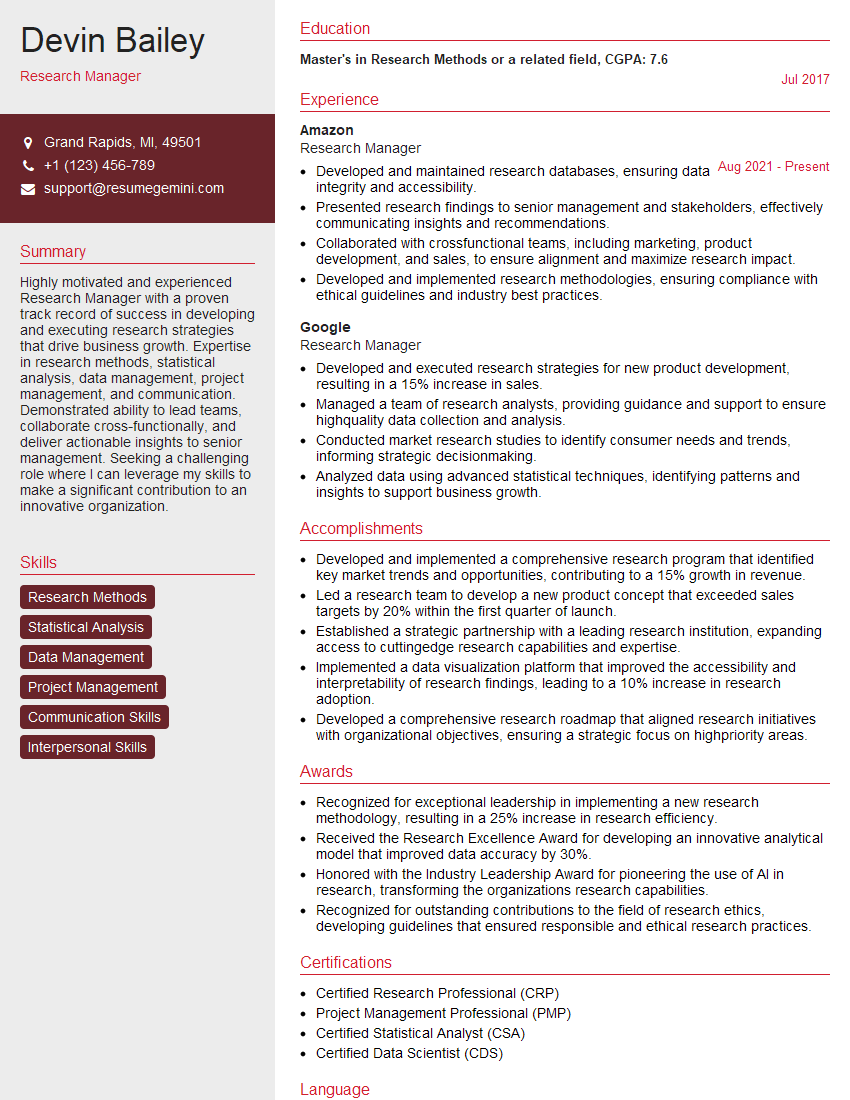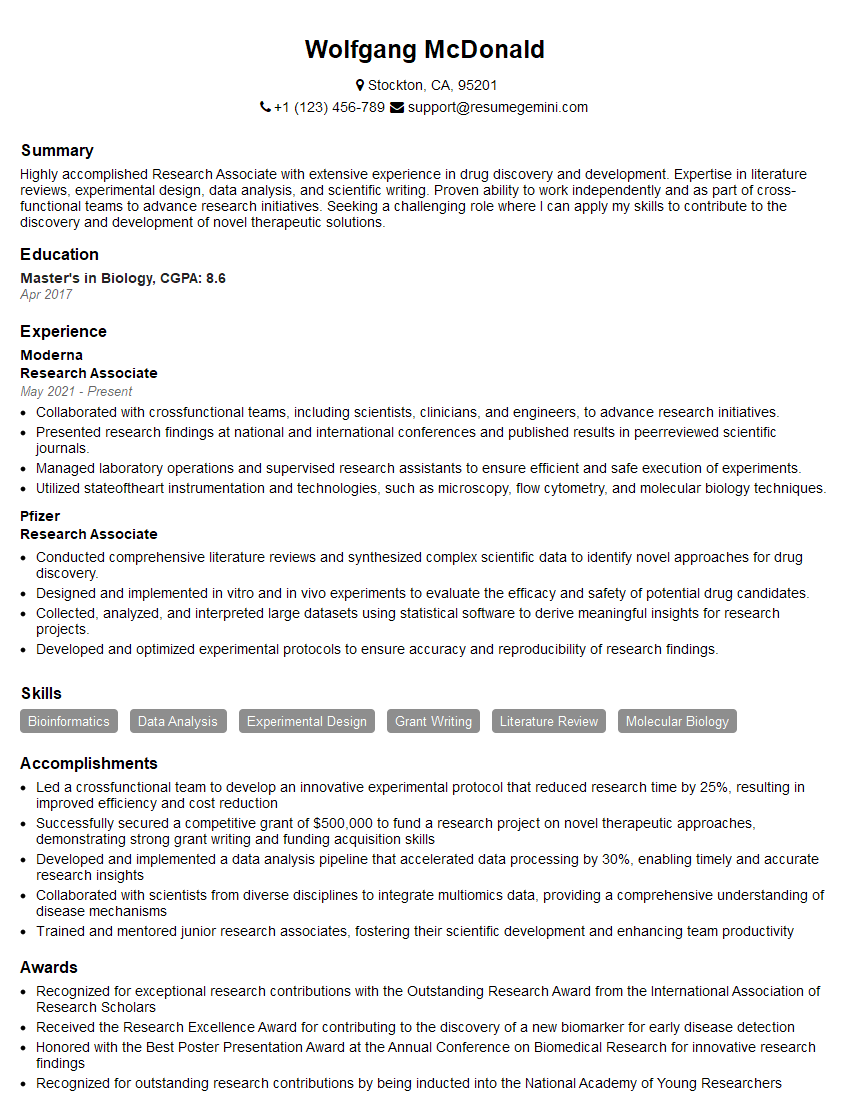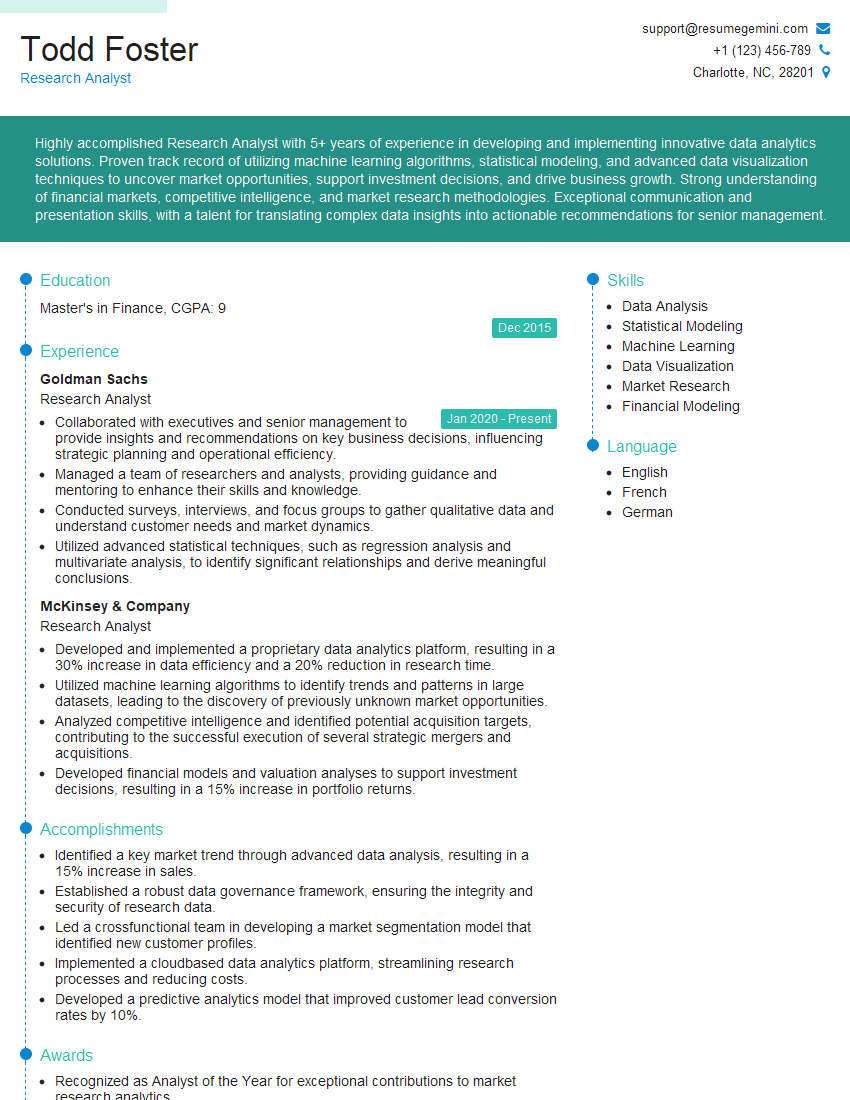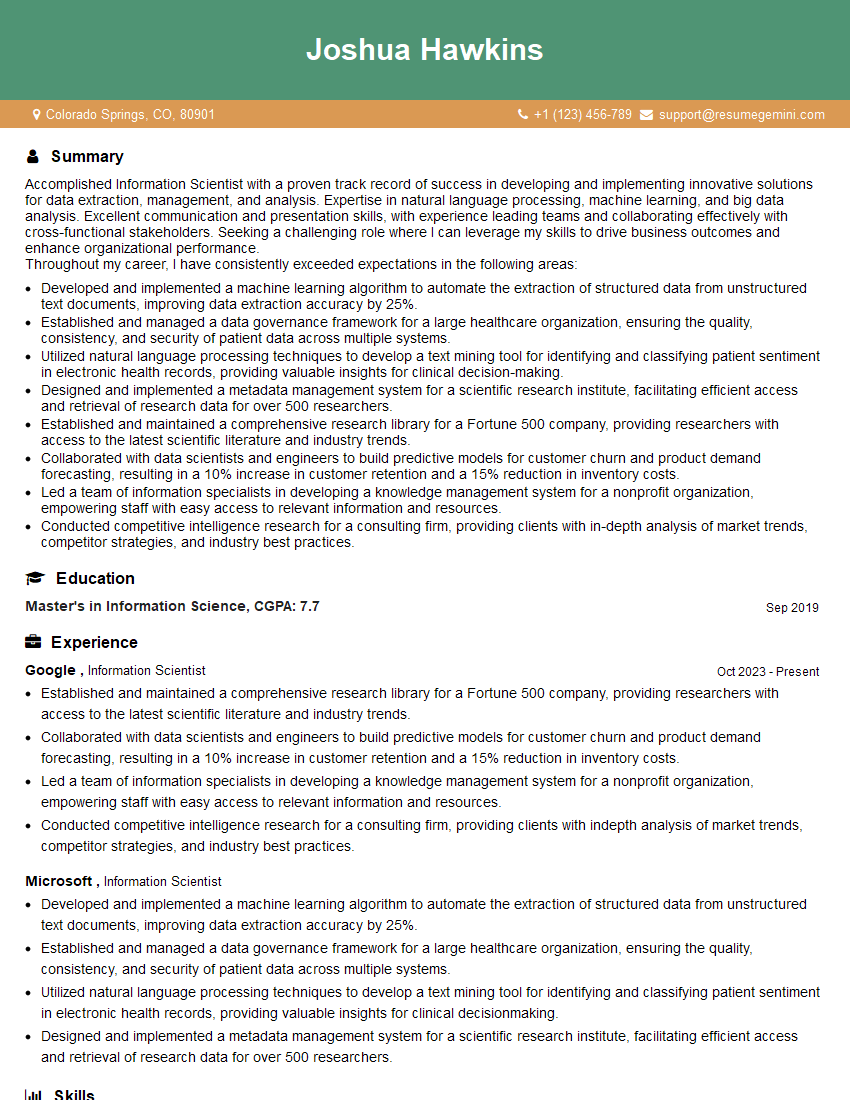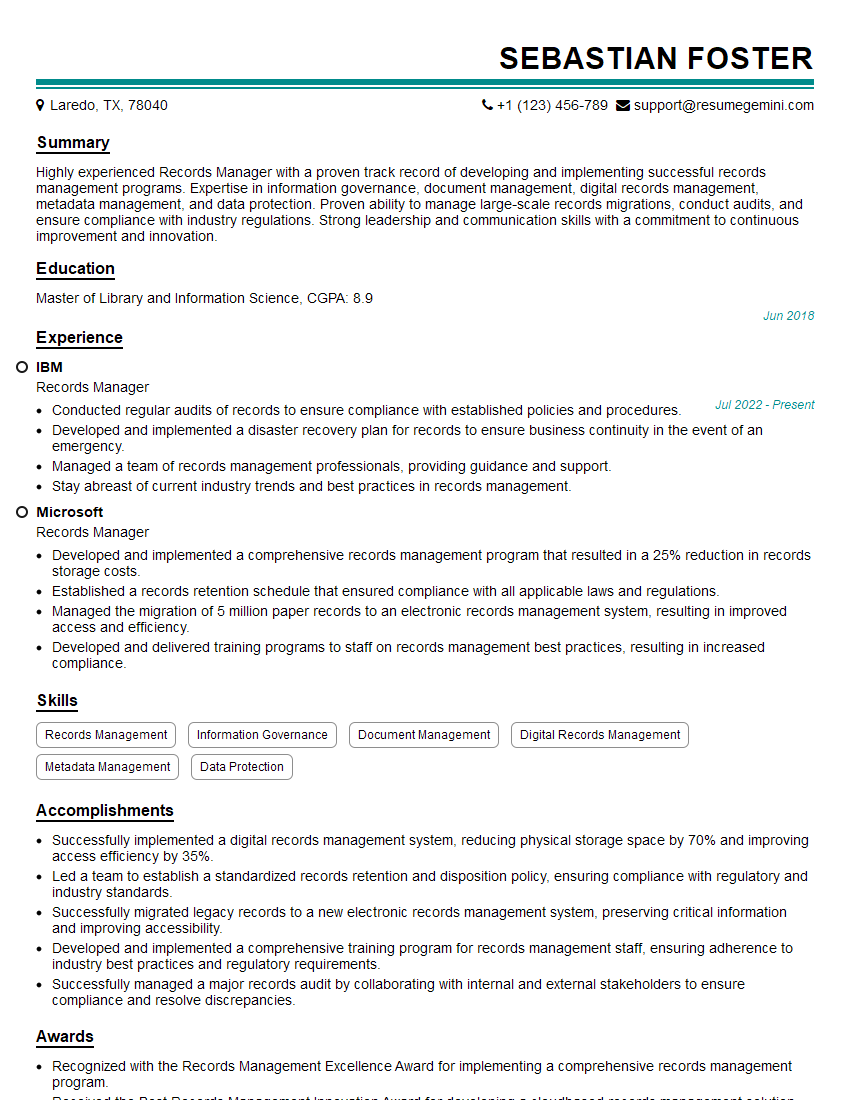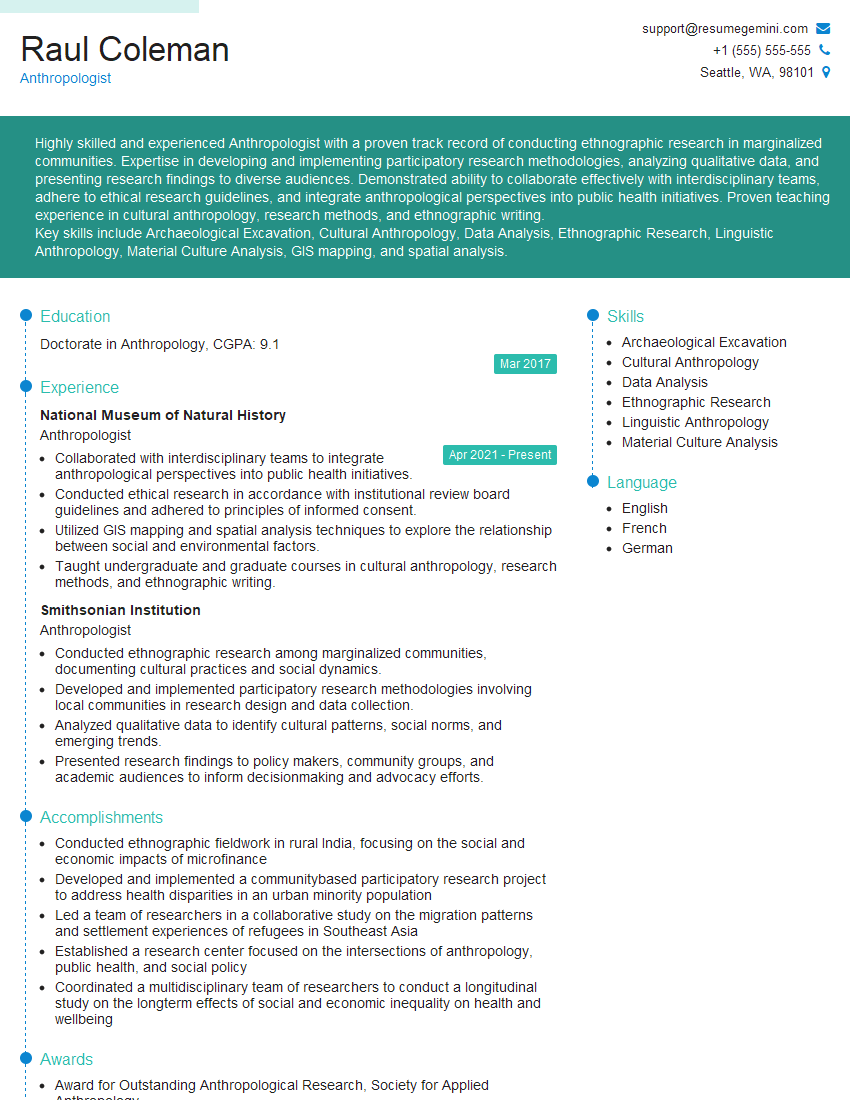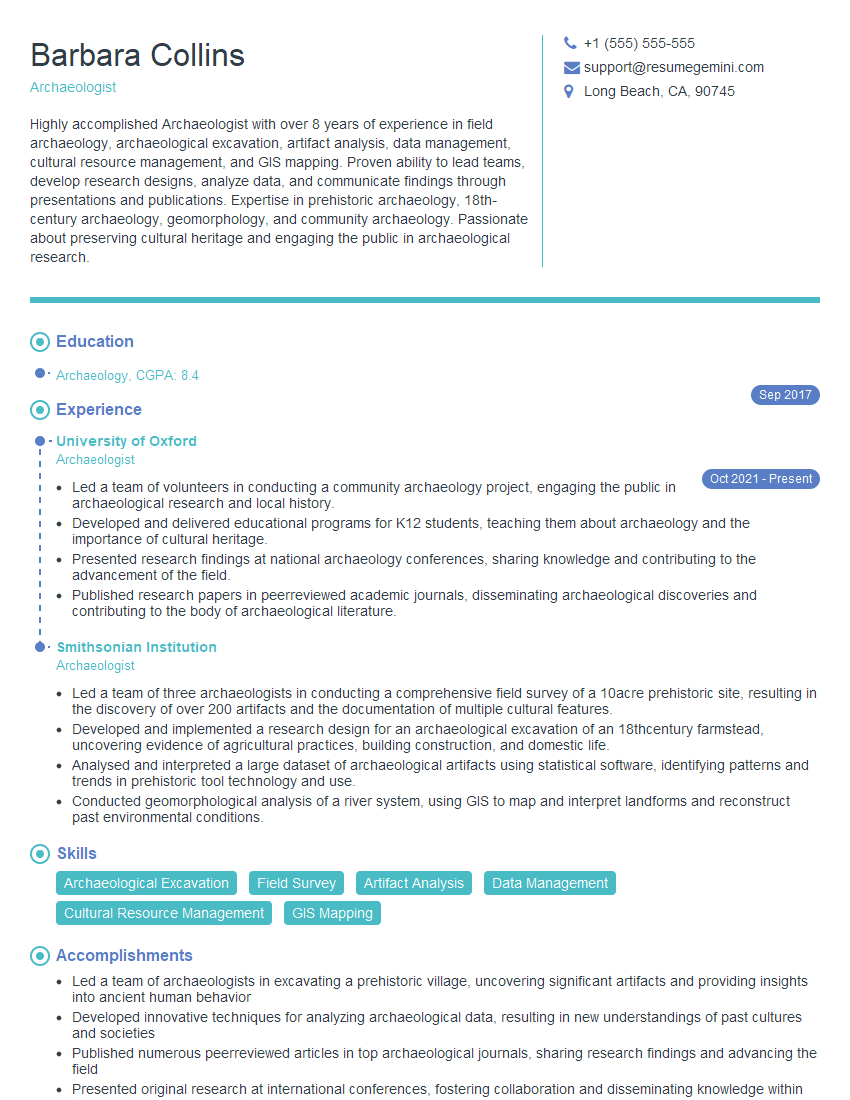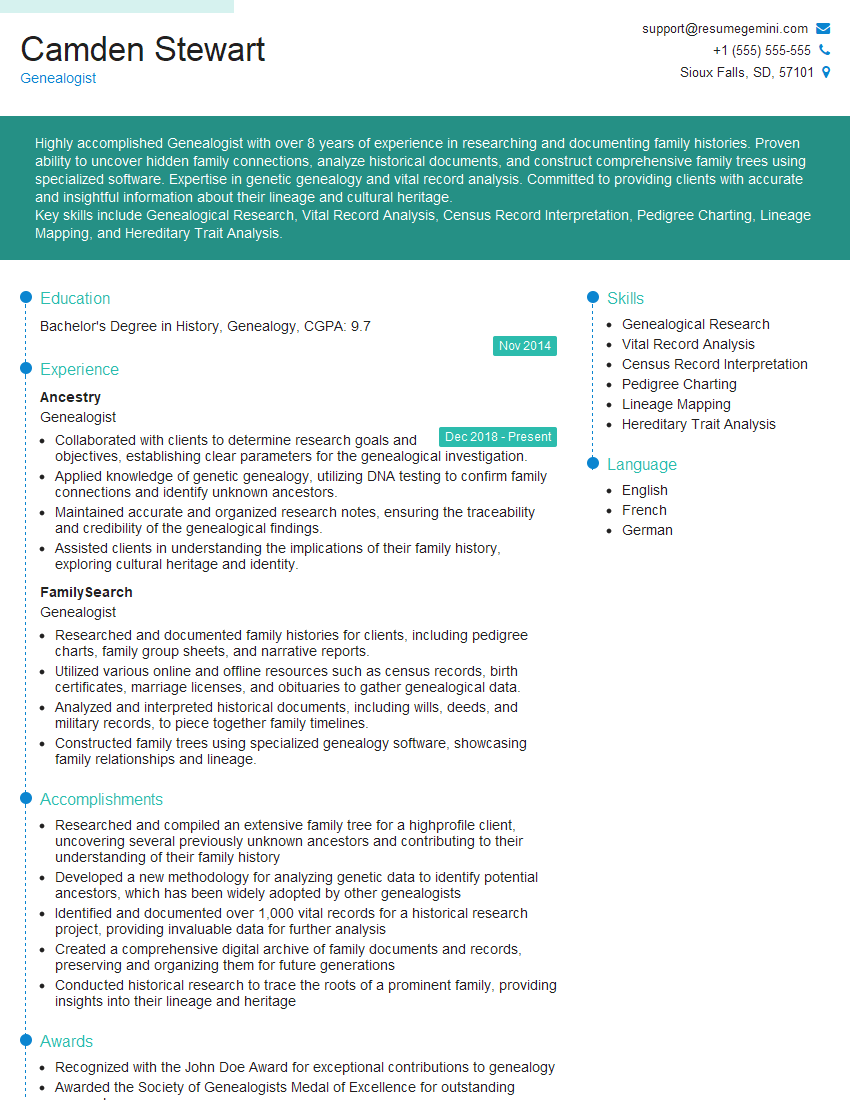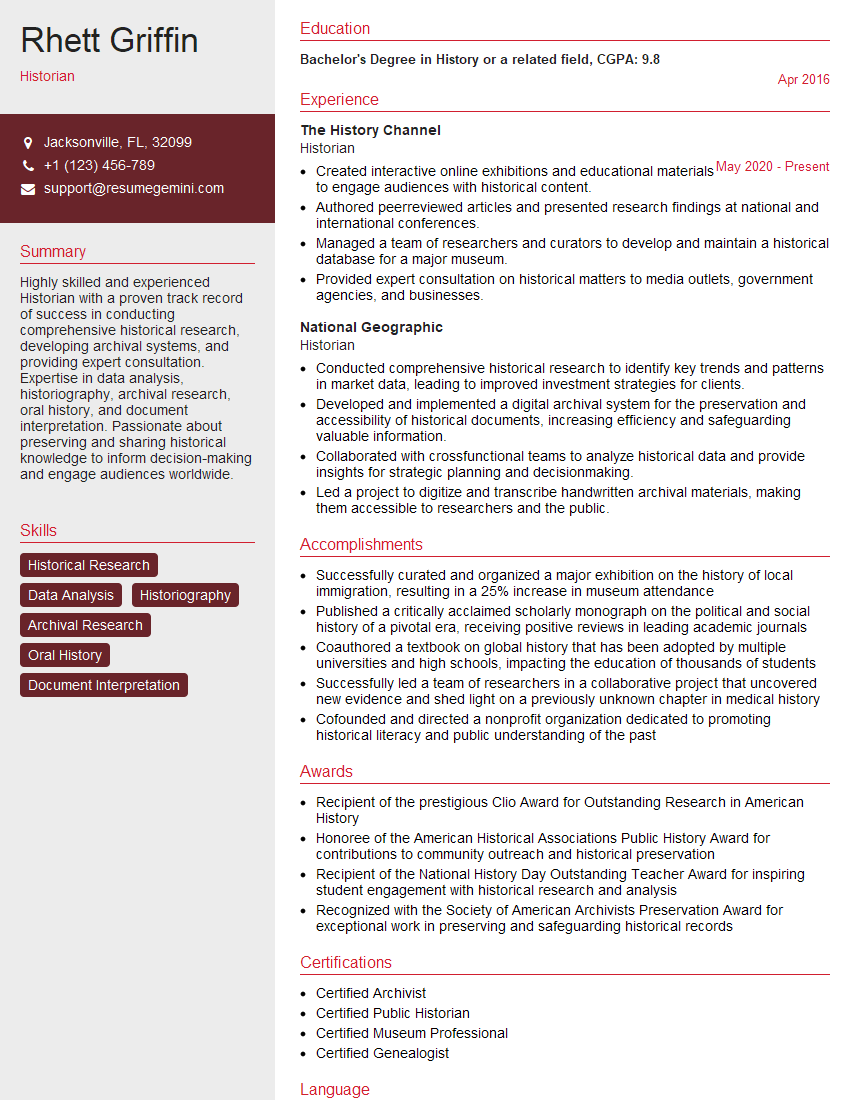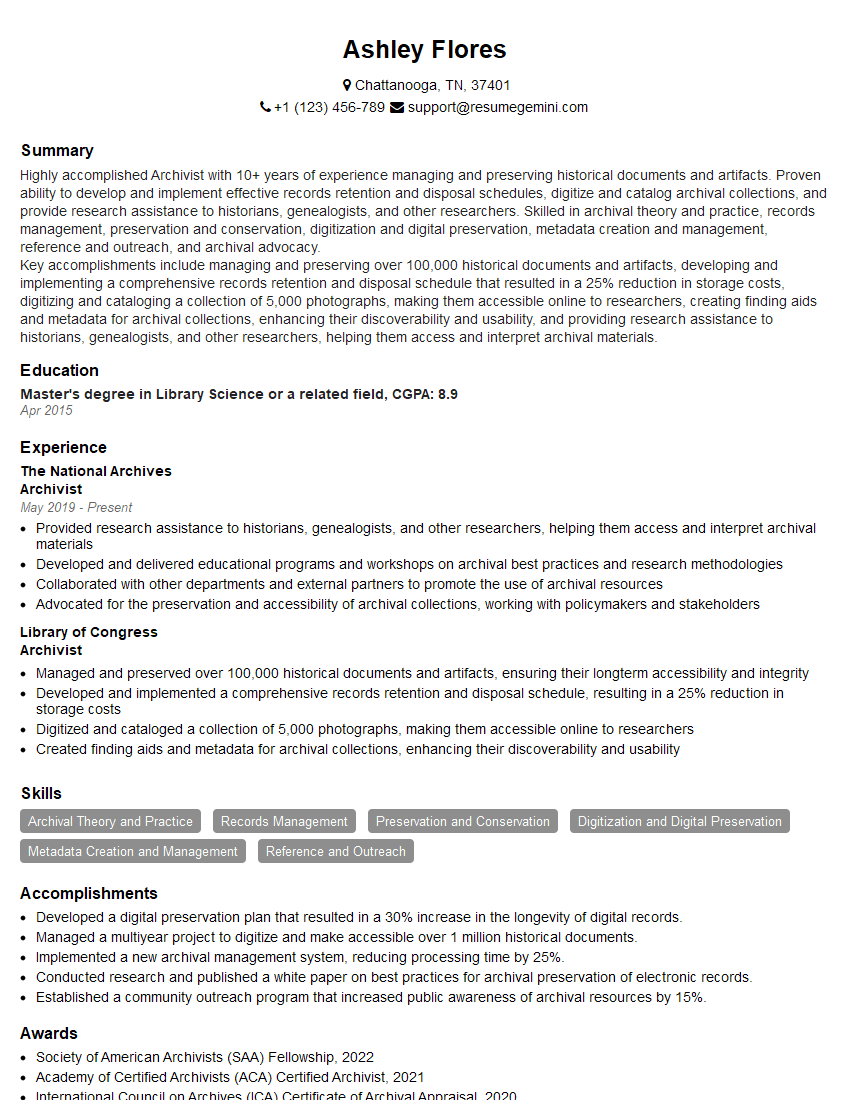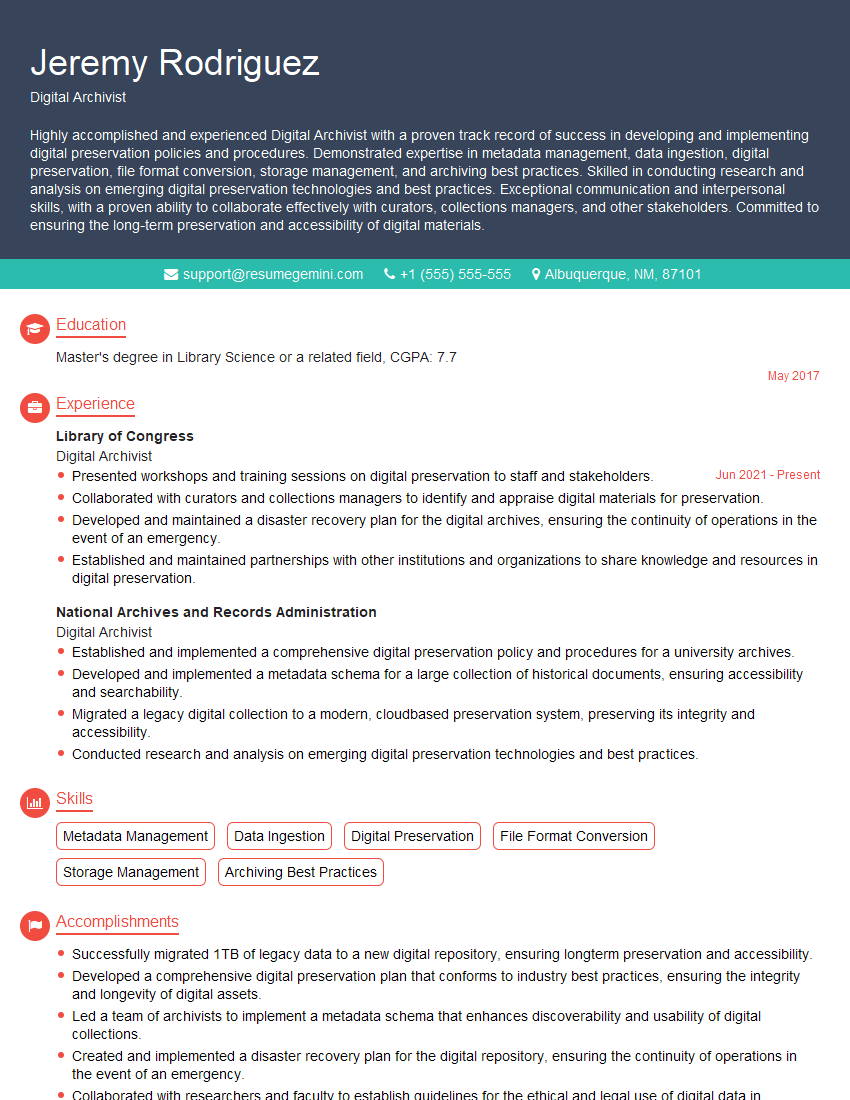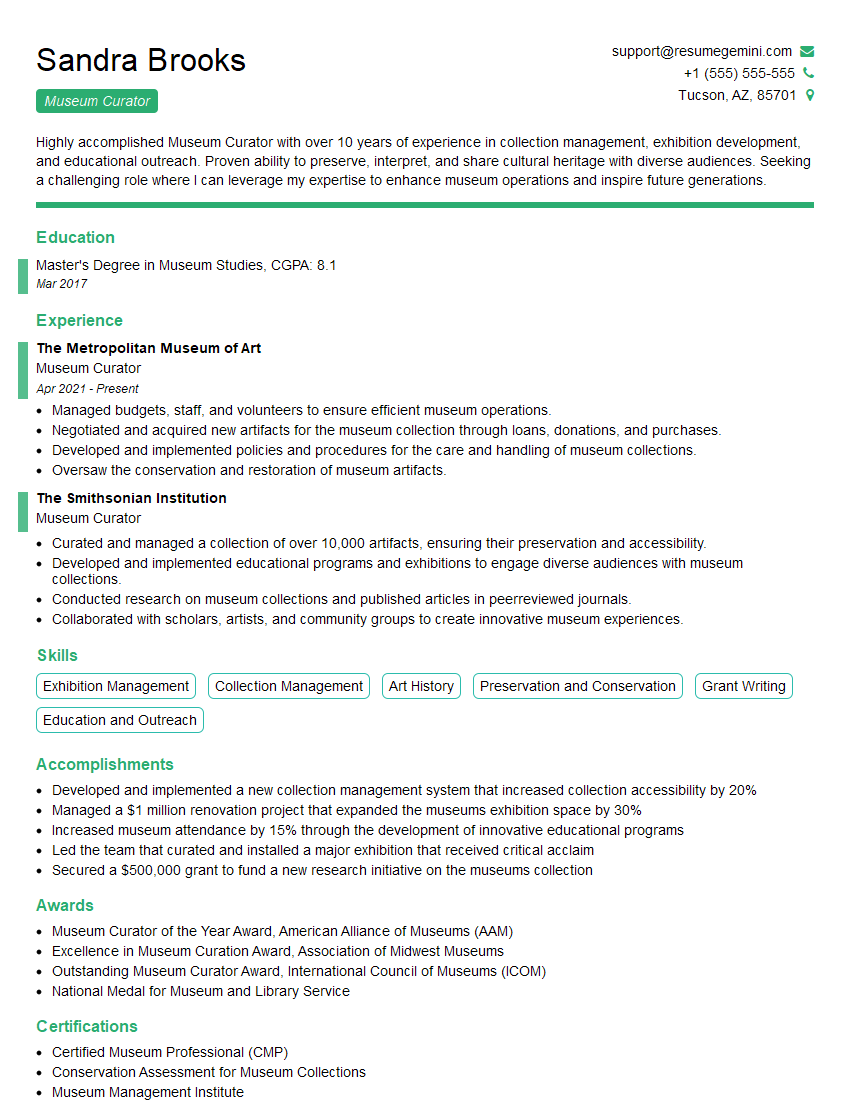Feeling uncertain about what to expect in your upcoming interview? We’ve got you covered! This blog highlights the most important Research and Historical Context interview questions and provides actionable advice to help you stand out as the ideal candidate. Let’s pave the way for your success.
Questions Asked in Research and Historical Context Interview
Q 1. Describe your experience with primary source verification.
Primary source verification is the cornerstone of historical research. It involves meticulously examining the authenticity and reliability of documents, artifacts, or other materials created during the historical period under investigation, not by someone writing about it later. This process isn’t simply about confirming that a document exists; it’s about establishing its provenance – its origin, authorship, and journey through time.
My approach involves several steps: Firstly, I carefully examine the physical characteristics of the source. For example, with a manuscript, I might look at the type of paper, the ink, the handwriting style, and any watermarks to determine its approximate age and origin. Secondly, I analyze the content for internal consistency and plausibility. Are the facts presented logical and consistent with other known information? Are there any obvious anachronisms (things out of place in time)? Finally, I compare the source to other known sources, corroborating its information where possible and investigating any discrepancies. For example, if a diary entry mentions a specific meeting, I would cross-reference it with other accounts or official records from that time.
Imagine investigating a claim about a historical battle. A primary source might be a soldier’s letter home, detailing the events. Verification involves scrutinizing the letter’s language, comparing handwriting to known samples if possible, and checking dates and locations against geographical and military records. Discrepancies would demand further investigation, perhaps involving consulting experts in palaeography (the study of old handwriting) or historical cartography.
Q 2. Explain your methodology for analyzing historical data.
My methodology for analyzing historical data is iterative and multi-faceted, combining qualitative and quantitative approaches depending on the nature of the data and research question. I begin by formulating a clear research question, which guides the entire process. Then, I select relevant sources, prioritizing primary sources whenever possible. These sources are then critically examined using techniques such as content analysis (identifying recurring themes or patterns) and textual analysis (examining the language, tone, and structure of the text).
Quantitative analysis might involve statistical methods if dealing with numerical data, like population census records or economic data. For instance, I might use statistical software to analyze demographic trends over time. Qualitative analysis, however, focuses on the interpretation of meaning in narratives, diaries, letters and oral histories, seeking to understand the subjective experiences and perspectives of historical actors. Throughout the analysis, I maintain a critical awareness of potential biases present in both the sources and my own interpretations. This requires careful consideration of authorial intent, historical context, and the limitations of available evidence. The cyclical nature of research means that initial analyses might lead to refining the research question or seeking out additional sources, leading to further iterations of analysis until a cohesive and well-supported interpretation is reached.
Q 3. How do you approach researching a topic with limited available sources?
Researching a topic with limited sources necessitates a creative and flexible approach. When faced with scarcity, I prioritize exploring related fields and extending the geographical and temporal scope of the investigation. For example, if sources are scarce on a specific local event, I might explore broader regional or national contexts to provide valuable background and comparative perspectives.
Furthermore, I utilize alternative source materials such as visual media (photographs, maps, paintings), oral histories (interviews with individuals with relevant knowledge), and archaeological evidence. Each of these offers different perspectives and can help fill gaps in the written record. Developing alternative research questions, perhaps focusing on a smaller, more manageable aspect of the initial topic, allows for more focused investigation with the available material. Finally, negative evidence – the absence of something in the records – can also be valuable. If a particular event isn’t mentioned in multiple sources, that absence itself might offer significant insights.
For example, researching a small, obscure village’s history might require leveraging regional archives, local museum collections, and even geological surveys to understand environmental factors that might have influenced its development. The limitations necessitate a resourceful approach, utilizing all available clues to construct a comprehensive, albeit potentially nuanced, narrative.
Q 4. What are the key differences between qualitative and quantitative historical research?
Qualitative and quantitative historical research differ fundamentally in their approaches and goals. Qualitative research emphasizes understanding the meaning, context, and interpretation of historical events. It often involves close reading of texts, analysis of narratives, and interpretation of visual or material culture. The focus is on in-depth understanding and nuanced interpretation, often generating rich descriptions and insights.
Quantitative research, on the other hand, is focused on numerical data and statistical analysis. It seeks to identify patterns, trends, and relationships in historical data sets using statistical methods. Examples include analyzing population trends using census data, or correlating economic indicators with social change. The objective is to identify and measure relationships between variables and to create generalized conclusions that can be tested and replicated. While both approaches contribute uniquely to historical knowledge, qualitative research emphasizes understanding, while quantitative strives for measurement and generalization.
Q 5. How do you evaluate the credibility of historical sources?
Evaluating the credibility of historical sources is a crucial skill. It requires a systematic approach, considering several factors. Firstly, I examine the authorship and provenance of the source. Who created it? When was it created? Under what circumstances? Understanding the author’s background, potential biases, and intended audience is vital in interpreting their work. Secondly, I assess the source’s internal consistency. Are the facts presented logical and consistent within the source itself? Are there any contradictions or inconsistencies that raise questions about its reliability?
Thirdly, I compare the source to other available sources. Does it corroborate other evidence or contradict it? Discrepancies require further investigation and critical evaluation. The context of creation is also crucial; political or social pressures might have influenced the creation of a source and affect its reliability. Finally, I evaluate the source’s potential biases. For example, a personal diary might reflect the author’s subjective opinions and experiences, while official government documents might reflect a specific political agenda. A multifaceted approach, combining these considerations, leads to a well-informed assessment of credibility.
Q 6. Explain your process for synthesizing information from multiple historical sources.
Synthesizing information from multiple historical sources is a complex process requiring careful analysis and interpretation. My process begins with organizing the sources chronologically or thematically, depending on the research question. Each source is analyzed individually, noting key themes, arguments, and evidence presented. Then, I identify areas of convergence and divergence among the sources. Where do the sources agree? Where do they disagree? What factors might explain the discrepancies?
I also look for patterns and themes emerging across the sources. Are certain interpretations or perspectives consistently represented, while others are absent? The next step is to construct a narrative that integrates the information from various sources, acknowledging areas of uncertainty or disagreement. This narrative needs to be logically coherent, well-supported by evidence, and reflect the nuances and complexities revealed by the sources. It’s like putting together a jigsaw puzzle: some pieces fit easily, others need more work, and some may even be missing. The goal is to create the most complete and accurate picture possible using the available pieces.
Q 7. How do you handle conflicting historical accounts?
Conflicting historical accounts are common, and handling them requires careful analysis and interpretation. I begin by identifying the points of conflict and examining the sources involved in the discrepancy. The next step is to evaluate the credibility of each source using the methods outlined previously. Which sources are more reliable? What biases might explain the discrepancies?
Context is crucial in resolving conflicts. Sometimes seemingly contradictory accounts can be reconciled by considering the differing perspectives and biases of the authors, or by recognizing that the accounts describe different aspects of the same event. Sometimes, there is no definitive resolution, and the historian must acknowledge the existence of conflicting interpretations, explaining the reasons for the divergence. The goal is not necessarily to find a single “truth” but to present a balanced and nuanced account that reflects the complexity of the historical record. It’s often more productive to highlight the disagreements and explore the reasons behind them than to force a premature consensus.
Q 8. Describe a time you had to interpret ambiguous historical data.
Interpreting ambiguous historical data is a cornerstone of historical research. Often, sources are incomplete, contradictory, or deliberately misleading. For example, during my research on the social impact of the Industrial Revolution in Manchester, I encountered conflicting accounts of worker living conditions. Some official reports painted a picture of improving conditions, while personal diaries and letters from workers revealed stark realities of poverty and disease. To address this ambiguity, I employed several strategies. First, I triangulated my data, comparing the official reports with the personal accounts and supplementing them with demographic data (like mortality rates) and physical evidence from the period. Second, I carefully considered the biases inherent in each source. The official reports, for instance, likely sought to downplay negative aspects to protect the image of industrial leaders. Finally, I placed the conflicting narratives within their broader historical context, understanding that the subjective experiences of individuals and the agendas of official institutions often resulted in discrepancies.
Q 9. What are some common biases found in historical sources, and how do you account for them?
Historical sources are rife with biases. Understanding and accounting for these is crucial for credible research. Common biases include:
- Authorial Bias: The author’s personal beliefs, social standing, and political affiliations invariably shape their perspective and narrative. A wealthy landowner’s account of a peasant uprising will differ greatly from a peasant’s firsthand account.
- Survivorship Bias: We only have access to sources that survived the passage of time. Materials that were deemed less important, or that challenged dominant narratives, might be lost or destroyed, skewing our understanding.
- Confirmation Bias: Researchers might unconsciously favor evidence that supports their pre-existing hypotheses, neglecting contradictory information. This is why a rigorous methodology, including open-mindedness to alternative interpretations, is essential.
- Nationalist/Ideological Bias: Historical accounts are often shaped by nationalistic or ideological agendas, glorifying certain events or figures while suppressing others. For example, wartime propaganda often presents a highly selective and biased perspective.
To account for these biases, I utilize critical analysis techniques. This includes comparing multiple sources, examining the author’s background and motivations, cross-referencing with other forms of evidence (e.g., archaeological finds), and being aware of my own potential biases while interpreting data. The goal isn’t to eliminate bias entirely – that’s impossible – but to understand and acknowledge its influence on the sources and mitigate its impact on my conclusions.
Q 10. How do you ensure the accuracy and reliability of your research findings?
Accuracy and reliability in historical research demand a multi-faceted approach. Firstly, I prioritize the use of primary sources – documents, artifacts, and other materials created during the period under study. These provide the most direct evidence, though they must be critically examined for bias, as discussed earlier. Secondly, I utilize a variety of primary sources, avoiding overreliance on a single source or type of source. Triangulation, as mentioned before, is a powerful tool for verifying information. Thirdly, I employ rigorous methodological approaches, such as close reading, textual analysis, and comparative historical analysis, depending on the nature of the sources and research questions. Lastly, my findings are peer-reviewed and subjected to scholarly scrutiny before publication, further enhancing their accuracy and reliability.
Q 11. Explain your experience with archival research.
Archival research forms the backbone of much of my work. I’ve spent countless hours in various archives, including the National Archives, local historical societies, and university libraries. My experience encompasses navigating complex cataloging systems, identifying relevant materials, and employing effective search strategies. For example, while researching the history of women’s suffrage, I spent weeks sifting through personal letters, meeting minutes, and newspaper articles. The challenge often lies not just in finding materials, but in deciphering old handwriting, understanding archaic terminology, and piecing together fragmented information. I’ve become proficient in using various tools for this, such as digital image enhancement software and historical dictionaries. Archival work necessitates patience, meticulous attention to detail, and a deep understanding of the context in which the materials were created.
Q 12. Describe your familiarity with different historical research methodologies.
My research utilizes a range of methodologies, tailored to the specific research question and available sources. These include:
- Quantitative Methods: Analyzing numerical data, such as census records or economic statistics, to identify trends and patterns over time. This might involve using statistical software to analyze large datasets.
- Qualitative Methods: Interpreting textual sources, such as personal diaries, letters, and official documents, to understand individual experiences, motivations, and beliefs. This often involves techniques like thematic analysis and discourse analysis.
- Comparative History: Comparing events and processes across different societies, time periods, or geographical locations to identify similarities and differences. This provides a broader perspective and allows for the identification of generalizable patterns.
- Oral History: Collecting and analyzing personal accounts of past events from individuals who experienced them. This offers unique insights into lived experiences that might be absent from written sources.
The choice of methodology is not arbitrary; it is driven by the research objectives and the nature of the available evidence.
Q 13. How do you manage large datasets in historical research?
Managing large datasets in historical research presents significant challenges. I frequently utilize tools like relational databases (e.g., MySQL, PostgreSQL) to organize and analyze large volumes of structured data, such as census data or digitized newspaper archives. For unstructured data, like transcribed oral histories or digitized manuscripts, I leverage text mining techniques and natural language processing (NLP) tools to identify patterns, themes, and key concepts. Tools such as NVivo or Atlas.ti aid in qualitative data analysis, allowing for coding and thematic analysis of large textual corpora. Data visualization techniques (histograms, charts, maps) are crucial to present complex findings in a clear and accessible manner. Careful data cleaning and validation are paramount to ensure data integrity and accuracy.
Q 14. How do you present complex historical information in a clear and concise manner?
Presenting complex historical information clearly and concisely requires careful consideration of the audience and the medium of presentation. I strive to use clear and accessible language, avoiding jargon whenever possible. Visual aids, such as maps, timelines, charts, and images, significantly enhance comprehension. I structure my presentations and writing logically, moving from broad context to specific details, with clear transitions between sections. Storytelling techniques are useful to engage the audience and make the information more relatable. For example, instead of simply stating statistical trends, I might weave a narrative around the lives of individuals whose experiences illustrate those trends. The ultimate goal is not just to convey factual information, but to help the audience understand the significance and implications of the historical events under consideration.
Q 15. How do you cite sources according to a specific style guide (e.g., Chicago, MLA)?
Proper citation is crucial for academic integrity, avoiding plagiarism, and allowing readers to verify your sources. Different style guides, like Chicago and MLA, have specific formatting rules. Let’s look at examples:
Chicago Style (Notes and Bibliography): This style uses footnotes or endnotes to cite sources within the text and a comprehensive bibliography at the end. For a book, a footnote might look like this:1
1Author's Last Name, Author's First Name. Book Title. City of Publication: Publisher, Year, Page Number.
In the bibliography, it would appear as:
Author's Last Name, Author's First Name. Book Title. City of Publication: Publisher, Year.
MLA Style: MLA uses parenthetical citations within the text, including the author’s last name and page number, and a Works Cited page at the end. For example: (Author’s Last Name Page Number).
(Smith 123)
The Works Cited entry would be:
Author's Last Name, Author's First Name. Title of Work. Publisher, Publication Date.
Each style has variations depending on the source type (journal article, website, etc.). Familiarizing yourself with the specific guide’s rules is key.
Career Expert Tips:
- Ace those interviews! Prepare effectively by reviewing the Top 50 Most Common Interview Questions on ResumeGemini.
- Navigate your job search with confidence! Explore a wide range of Career Tips on ResumeGemini. Learn about common challenges and recommendations to overcome them.
- Craft the perfect resume! Master the Art of Resume Writing with ResumeGemini’s guide. Showcase your unique qualifications and achievements effectively.
- Don’t miss out on holiday savings! Build your dream resume with ResumeGemini’s ATS optimized templates.
Q 16. Describe your experience using historical databases and online resources.
My experience with historical databases and online resources is extensive. I’ve utilized resources like JSTOR, Project MUSE, and various archival databases (e.g., Ancestry.com, Newspapers.com) for decades. I’m proficient in searching and navigating these platforms, employing Boolean operators (AND, OR, NOT) and advanced search techniques to refine results. For example, searching for “women’s suffrage AND 19th century” yields more precise results than a broad search for “suffrage.” I am also experienced with evaluating the credibility and reliability of online sources, considering factors like authorship, publication date, and potential bias.
Beyond databases, I’ve utilized digitized primary sources like letters, photographs, and government documents available online through university archives and other digital repositories. I regularly assess the metadata of digital resources to understand their context and limitations. This ensures a comprehensive and nuanced approach to research.
Q 17. How do you identify and address potential ethical concerns in historical research?
Ethical concerns in historical research are paramount. They center on issues of representation, privacy, and the potential for misinterpretation of the past. For example, when researching marginalized communities, it’s crucial to avoid perpetuating harmful stereotypes or narratives. This requires careful consideration of source bias and a commitment to representing diverse voices accurately and respectfully.
Addressing these concerns involves:
- Acknowledging biases: Recognizing potential biases within primary and secondary sources, including the author’s perspective and historical context.
- Respecting privacy: Protecting the privacy of individuals mentioned in historical records, particularly when dealing with sensitive information.
- Obtaining permission: If using personal accounts or images, seeking appropriate permissions from the relevant individuals or their descendants.
- Transparency and accountability: Clearly articulating methodological choices, sources, and potential limitations of the research. Being open about any challenges encountered in the research process.
Ethical conduct ensures that historical research is not only accurate but also responsible and sensitive to the human stories it explores.
Q 18. Explain your understanding of historical context and its importance in research.
Historical context refers to the social, political, economic, cultural, and intellectual circumstances surrounding a particular event, idea, or individual. It’s crucial because understanding the past requires more than just a chronological account; it demands an awareness of the forces shaping that past.
For instance, studying the American Civil War without understanding the preceding debates over slavery, states’ rights, and economic differences between the North and South provides an incomplete picture. Historical context enables us to interpret events and decisions within their relevant framework, revealing their complexities and interconnections.
In research, understanding historical context allows for more nuanced interpretations and avoids anachronistic judgments (applying contemporary values to the past). It adds depth and meaning to research findings, enhancing their significance and relevance.
Q 19. How do you incorporate technology into your historical research process?
Technology plays a transformative role in my historical research. I leverage digital tools for:
- Database searching: Utilizing advanced search features in online databases and archives.
- Digital archiving: Organizing and managing my research materials digitally using cloud storage and citation management software (e.g., Zotero).
- Data analysis: Employing statistical software (e.g., R, SPSS) to analyze quantitative data or create visualizations.
- Transcription and translation: Using optical character recognition (OCR) software to transcribe handwritten documents and translation software for multilingual sources.
- Digital mapping: Creating maps to visualize historical events and geographic data using GIS software.
These technological tools significantly enhance efficiency and enable sophisticated analyses that wouldn’t be feasible with traditional methods. For instance, I recently used GIS software to map the spread of a particular disease during a historical epidemic, revealing previously unseen patterns.
Q 20. Describe your experience with data visualization techniques in a historical context.
Data visualization is essential for communicating historical findings effectively. I use various techniques to present complex data in an accessible and engaging manner.
- Charts and graphs: Creating bar charts, line graphs, and pie charts to show trends and patterns in quantitative data (e.g., population changes over time, economic indicators).
- Maps: Using GIS software to create thematic maps visualizing geographical distributions of events or phenomena (e.g., migration patterns, battle locations).
- Network graphs: Illustrating relationships and connections between individuals, events, or concepts (e.g., social networks, trade routes).
- Infographics: Combining text, images, and charts to present complex information concisely.
For example, I once used a network graph to visualize the connections between key figures in a historical movement, revealing the intricate web of relationships that shaped the movement’s trajectory. Effective data visualization makes research more understandable and impactful for a wider audience.
Q 21. How do you ensure the objectivity of your research findings?
Objectivity in historical research is a continuous pursuit, not a perfectly attainable state. It demands rigorous methodology and a critical approach to sources. To ensure objectivity, I strive for:
- Multiple perspectives: Consulting various primary and secondary sources representing different viewpoints and interpretations.
- Source criticism: Evaluating the reliability, bias, and context of sources before using them in my research.
- Transparency of methods: Clearly outlining my research methodology, allowing others to assess the validity and potential limitations of my findings.
- Peer review: Seeking feedback from colleagues and experts in the field to identify potential biases or flaws in my research.
- Acknowledging limitations: Honestly acknowledging any limitations in my research and avoiding overgeneralizations or sweeping conclusions.
By actively engaging in these practices, I aim to produce research that is as unbiased and reliable as possible, recognizing that complete objectivity is an ideal to be approached rather than a fully achievable goal.
Q 22. What are some common pitfalls to avoid in historical research?
Historical research, while rewarding, is prone to several pitfalls. Avoiding these ensures the integrity and validity of your findings. One major issue is presentism – interpreting the past through the lens of the present. We must actively resist imposing our modern values and biases onto historical actors and events. For instance, judging a 17th-century monarch by 21st-century standards of human rights is inherently flawed.
Another common pitfall is confirmation bias, the tendency to seek out information that confirms pre-existing beliefs and ignore contradictory evidence. A researcher convinced of a specific narrative might unconsciously overlook sources that challenge it. To combat this, it’s vital to actively seek out diverse perspectives and critically evaluate all sources, including those that challenge your initial hypotheses.
Source criticism is crucial. This involves meticulously evaluating the reliability and authenticity of sources. Consider the author’s background, potential biases, the time elapsed since the event, and the intended audience. A single, uncorroborated source is rarely sufficient for building a robust argument. For example, relying solely on a biased personal diary to understand a major historical event is risky.
- Over-reliance on secondary sources: Always strive to engage with primary sources whenever possible to gain a firsthand understanding of the past.
- Ignoring context: Historical events rarely occur in isolation. Thorough contextualization is essential for accurate interpretation.
Finally, lack of transparency in methodology can undermine the credibility of research. Clearly articulating your research questions, methods, and sources allows others to scrutinize your work and assess its validity.
Q 23. Describe your experience in collaborative research projects.
I’ve been fortunate to participate in several collaborative research projects, and the experience has been invaluable. In one project, we investigated the impact of the Industrial Revolution on working-class families in Victorian England. Our team consisted of historians specializing in social history, economic history, and demography. This interdisciplinary approach enriched our understanding, allowing us to analyze the issue from diverse perspectives.
Collaborative research requires excellent communication and a shared understanding of research goals. We held regular meetings to discuss findings, address disagreements, and ensure that the project remained on track. One key challenge was coordinating our individual research efforts. To overcome this, we established clear timelines and responsibilities, using project management software to track progress and share documents. The collaborative nature of the project fostered innovative ideas and robust analysis that likely would not have been achieved through solo research.
Another project focused on the digital humanities, analyzing large datasets of historical newspapers to identify trends in public opinion. This project demanded expertise in both historical analysis and computational methods, highlighting the benefits of interdisciplinary collaboration. The ability to leverage diverse skill sets significantly enhanced the quality and scope of our findings.
Q 24. How do you stay current with the latest research and developments in your field?
Staying current in historical research requires a multi-faceted approach. I regularly subscribe to and read leading academic journals in my area of expertise, such as the Journal of Modern History and the American Historical Review. Attending conferences and workshops allows me to network with other scholars, learn about cutting-edge research, and engage in stimulating discussions.
I also actively utilize online databases such as JSTOR and Project MUSE, which provide access to a vast collection of scholarly articles and books. Following prominent scholars on social media platforms like Twitter can also be informative, as they often share their latest publications and research findings. I make sure to participate in online scholarly communities and forums to engage in ongoing discussions and debates.
Furthermore, I dedicate time to exploring new methodologies and technologies relevant to my research. This might involve learning new software for data analysis or exploring emerging digital humanities techniques to enhance the efficiency and scope of my work. A continuous learning process is essential to adapt to the constantly evolving field of historical research.
Q 25. How do you adapt your research methods to different types of historical questions?
Adapting research methods depends entirely on the specific historical question being asked. For instance, investigating the social life of a small village might involve qualitative methods such as oral history interviews and detailed analysis of local records. These methods focus on in-depth understanding of individual experiences and social dynamics.
Conversely, analyzing the impact of a major war might require quantitative methods, focusing on large-scale datasets like military records, economic statistics, and demographic information. Here, statistical analysis might be employed to identify patterns and correlations. The type of historical question guides the selection of appropriate sources and research approaches. In some cases, a mixed-methods approach – combining both quantitative and qualitative techniques – can provide a more complete understanding. For instance, using quantitative data on migration patterns alongside qualitative interviews with migrants provides richer insights into the subject.
For example, if I’m exploring the impact of a specific law on social attitudes, I might use quantitative analysis of census data to track changes in population demographics related to that law. However, I’d also use qualitative methods such as analyzing newspaper articles, personal letters, and government documents to gain a deeper understanding of the public perception and experiences related to that law. This mixed-methods approach helps avoid the limitations of each method in isolation.
Q 26. Describe a time you had to overcome a significant challenge in your research.
During my doctoral research on the social history of 19th-century immigration, I encountered significant challenges accessing archival materials. The records I needed were scattered across multiple archives in different countries, some of which were poorly organized or lacked digital indexes. This made it time-consuming and often frustrating to locate relevant documents.
To overcome this, I developed a systematic research strategy. I began by compiling a comprehensive list of potential archives, then contacted each one individually, outlining my research interests and requesting assistance in locating relevant documents. I learned to navigate diverse archival systems and effectively communicate my research needs to archivists. I also leveraged online databases and digital catalogs to locate digitized materials and identify potential leads.
Furthermore, I developed strong relationships with archivists in various institutions. These connections proved invaluable, as they often alerted me to newly discovered collections or overlooked documents relevant to my research. The process required patience, persistence, and adaptability, demonstrating the importance of resourcefulness in overcoming obstacles in historical research.
Q 27. Explain your understanding of historical periodization.
Historical periodization is the process of dividing history into distinct periods, each with its own defining characteristics and chronological boundaries. This is a crucial concept for organizing and interpreting historical events. However, it’s important to remember that periodization is a construct, a tool historians use to analyze the past, not an objective reflection of historical reality itself. The boundaries between periods are often fluid, and different historians may adopt different periodization schemes.
For example, the commonly used periodization of the European Middle Ages, Renaissance, and Modern Period is itself a construct, developed over time and subject to ongoing debate. The transition between these periods wasn’t abrupt; rather, it involved gradual changes in social, political, and cultural spheres. Different scholars may place emphasis on distinct factors when defining the characteristics and boundaries of periods. Some may emphasize technological innovations while others focus on changes in political systems or religious beliefs.
Understanding historical periodization requires a critical awareness of the choices historians make when classifying the past. Recognizing the subjective nature of periodization is essential for avoiding overly simplistic or deterministic interpretations of historical processes. For example, simply labeling an entire century as ‘the age of reason’ neglects the complexities and contradictions within that era.
Key Topics to Learn for Research and Historical Context Interview
- Source Evaluation & Critique: Understanding methodologies for assessing the reliability, bias, and validity of historical sources; applying critical thinking to primary and secondary materials.
- Historiographical Approaches: Familiarity with different historical interpretations and schools of thought; analyzing how historical narratives are constructed and contested.
- Research Design & Methodology: Developing focused research questions; selecting appropriate research methods (e.g., archival research, oral history, quantitative analysis); designing effective research projects.
- Data Analysis & Interpretation: Extracting meaningful insights from historical data; using evidence to support arguments and interpretations; presenting findings clearly and concisely.
- Contextualization & Synthesis: Placing historical events and phenomena within their broader social, political, economic, and cultural contexts; synthesizing information from diverse sources to create a coherent narrative.
- Ethical Considerations in Research: Understanding ethical principles related to historical research, including issues of representation, bias, and access to sources.
- Presentation & Communication of Research: Effectively communicating research findings through written reports, presentations, and other formats; adapting communication style to different audiences.
Next Steps
Mastering research and historical context skills is crucial for career advancement in many fields, opening doors to exciting opportunities and impactful contributions. A strong understanding of these areas demonstrates critical thinking, analytical ability, and the capacity for in-depth investigation – qualities highly valued by employers. To maximize your job prospects, crafting an ATS-friendly resume is essential. ResumeGemini is a trusted resource that can help you build a professional and effective resume that highlights your skills and experience. We provide examples of resumes tailored to Research and Historical Context to help you get started. Take the next step towards your dream career – build a compelling resume with ResumeGemini today!
Explore more articles
Users Rating of Our Blogs
Share Your Experience
We value your feedback! Please rate our content and share your thoughts (optional).
What Readers Say About Our Blog
Hello,
We found issues with your domain’s email setup that may be sending your messages to spam or blocking them completely. InboxShield Mini shows you how to fix it in minutes — no tech skills required.
Scan your domain now for details: https://inboxshield-mini.com/
— Adam @ InboxShield Mini
Reply STOP to unsubscribe
Hi, are you owner of interviewgemini.com? What if I told you I could help you find extra time in your schedule, reconnect with leads you didn’t even realize you missed, and bring in more “I want to work with you” conversations, without increasing your ad spend or hiring a full-time employee?
All with a flexible, budget-friendly service that could easily pay for itself. Sounds good?
Would it be nice to jump on a quick 10-minute call so I can show you exactly how we make this work?
Best,
Hapei
Marketing Director
Hey, I know you’re the owner of interviewgemini.com. I’ll be quick.
Fundraising for your business is tough and time-consuming. We make it easier by guaranteeing two private investor meetings each month, for six months. No demos, no pitch events – just direct introductions to active investors matched to your startup.
If youR17;re raising, this could help you build real momentum. Want me to send more info?
Hi, I represent an SEO company that specialises in getting you AI citations and higher rankings on Google. I’d like to offer you a 100% free SEO audit for your website. Would you be interested?
Hi, I represent an SEO company that specialises in getting you AI citations and higher rankings on Google. I’d like to offer you a 100% free SEO audit for your website. Would you be interested?
good
